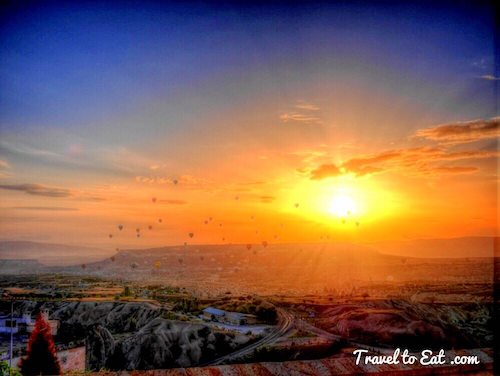
We decided to go with my friend to stay in his house in Uchisar, Cappidocia. It is only a one hour flight from Istanbul. It is about 4,000 feet in elevation and has cold winters with snow but during the summer the weather is crisp and cool. The area is a popular tourist destination, as it has many areas with unique geological, historic, and cultural features. The region is located southwest of the major city Kayseri, which has airline and railway service to Ankara and Istanbul and other cities. The most important towns and destinations in Cappadocia are Urgup, Goreme, Ihlara Valley, Selime, Guzelyurt, Uchisar, Avanos and Zelve. Among the underground cities worth seeing are Derinkuyu, Kaymakli, Gaziemir and Ozkanak. The best historic mansions and cave houses for tourist stays are in Urgup, Goreme, Guzelyurt and Uchisar.




The earliest record of the name of Cappadocia dates from the late 6th century BC, when it appears in the trilingual inscriptions of two early Achaemenid kings, Darius I and Xerxes, as one of the countries (Old Persian dahyu-) of the Persian Empire. In these lists of countries, the Old Persian name is Katpatuka, which is Hittite for Land of the Beautiful Horses. Cappadocia is also mentioned in the biblical account given in the book of Acts 2:9. The Cappadocians were named as one group hearing the Gospel account from Galileans in their own language on the day of Pentecost shortly after the resurrection of Jesus Christ. Acts 2:5 Following the Late Hittite and Persian aras, the Cappadocian Kingdom was established in 332 B.C. During the Roman era the area served as a shelter for the early escaping Christians. There are also several underground cities used by early Christians as hideouts in Cappadocia.



Cappadocia is one of Turkey's most visually striking regions, especially the “moonscape” area around the towns of Ürgüp, Göreme, Uçhisar, Avanos and Mustafapaşa (Sinasos), where erosion has formed caves, clefts, pinnacles, “fairy chimneys” and sensuous folds in the soft volcanic rock.


Cappadocia is one of the biggest wine-producing regions in Turkey, and many wineries thoroughout the region's towns offer winetasting options. The prices have been going up because of increased taxes by the government.


It is believed that the first signs of monastic activity in Cappadocia date back to the 4th century at which time small anchorite communities, acting on the teachings of Basileios the Great, Bishop of Kayseri, began inhabiting cells hewn in the rock. In later periods, in order to resist Arab invasions, they began banding together into troglodyte villages or subterranean towns such as Kaymakli or Derinkuyu which served as places of refuge. Cappadocian monasticism was already well established in the iconoclastic period (725-842) as illustrated by the decoration of many sanctuaries which kept a strict minimum of symbols (most often sculpted or tempera painted crosses). However, after 842 many rupestral churches were dug in Cappadocia and richly decorated with brightly coloured figurative painting. Those in the Göreme Valley or Open Air Museum include Tokalı Kilise and El Nazar Kilise (10th century), St. Barbara Kilise and Saklı Kilise (11th century) and Elmalı Kilise and Karanlık Kilise (end of the 12th – beginning of the 13th century).
This has just been an introduction to Cappidocia, now that we have established it's place in history, I will be doing more extensive posts on specific subjects.
References:
Babylonian World Map: /babylonian-world-map-british-museum-london/
Unesco: http://whc.unesco.org/en/list/357

